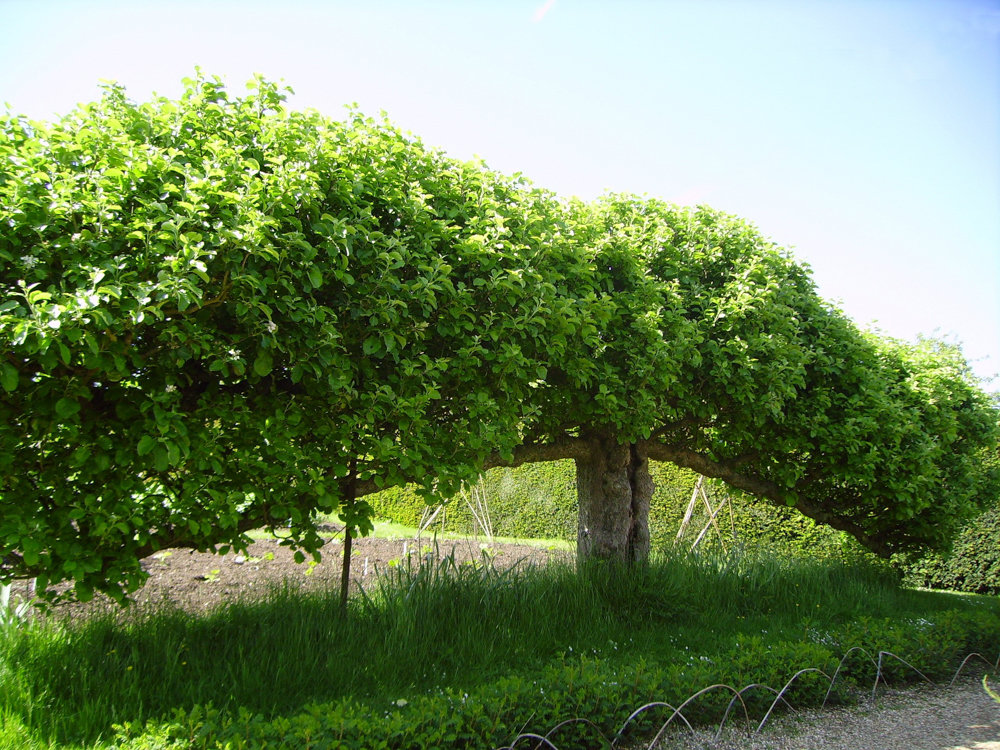These are trees that look like they want to hug you right back
The last time we met, we began our discussion of the various techniques used to shape and modify trees with a brief discussion of pruning and grafting. Things are about to get more interesting!
“Espalier” is a French term derived from the Italian spalliera. Spalla means “shoulder” and espalier, therefore, means “something to lean one’s shoulder against.”
This method was used during the Middle Ages to allow fruit trees to be grown inside and along castle walls both to preserve the open courtyard and to utilize the heat reflected from the nearby wall prolonging the tree’s growing season. (The castle walls become the “shoulders.”)
Essentially, some of the tree branches are trained along horizontal wires with extraneous growth removed by pruning, thereby transforming trees from three-dimensional plants to two-dimensional ones.
Espalier utilizes three primary designs:
• The stepover, which has only one row of trained branches.
• The classic espalier, which has two or three rows.
• The cordon, which has a main trunk with short lateral branches growing at 45-degree angles carrying the fruit and flowers.
A version of the cordon is the super column in which the trunk is allowed to grow up to eight feet, allowing it to be used as patio decoration. The classic espaliered fruit trees are still grown today as decorative elements while also affording easy harvesting.
Everybody recognizes topiaries. These are the forms into which evergreen trees and shrubs are sheared to create geometric shapes and creatures both recognizable and fanciful. Even flat-topped hedges are a simple form of topiary. Yews, myrtles and boxwood are favorite plants for this method.
A modern variant of this concept uses ivy plants wrapped around design scaffolds. Regular pruning, in all cases, is necessary to prevent the foliage from overgrowing and blurring the edges of the design.
Topiary — which was already being practiced in Roman times — is a term from the late 16th century. The French topiare is derived from the Latin topiaries, meaning “ornamental gardener,” having itself been derived from the Greek topos, where it simply means “place.”
Topiary has several variants — cloud-pruning, bonsai and penjing. The first two are Japanese artistic forms, and the last is Chinese.
Cloud-pruning is much like western topiary where the tops of adjoining shrubs are clipped in a flowing pattern designed to resemble a bank of clouds. It can be differentiated from classic bonsai since the trees growing outdoors planted in soil, while in bonsai, the plant is grown in a pot.
Bonsai also tries to create miniature versions of ancient twisted and textured trees, which is accomplished by root cuttings and the careful training of branches.
Penjing also uses miniaturized plants, but instead of simply highlighting dramatic tree forms, it creates a complete landscape by using other materials such as rocks to symbolize cliffs. The Japanese also developed a similar art form after World War II called saikei.
Penjing, however, is an ancient art form.
Pollarding and coppicing are closely related techniques. In essence, the tree trunk is cut down to a particular length so that new shoots will grow out of the remaining trunk or stump. The essential difference is the height at which the cut is made.
A coppiced tree is cut to a foot or less above the soil, and can only be done in the absence of livestock, who will otherwise eat the new shoots. Pollarding is done around the six-foot level. Those olive trees with ancient gnarled trunks appear to be the result of pollarding.
Not all tree species can survive coppicing or pollarding. Broadleaf species such as beeches, oaks, mulberries and black locust do just fine, but few conifers can handle such treatment. Although it can take years for treated trees to yield shoots for basketry and firewood, it does allow regular harvesting from a single tree. And, of course, it is used today in gardens to keep trees within a manageable size.
Pleaching includes elements of espalier and inosculation (self-formed grafts) in addition to the tight weaving of branches. The etymology clearly indicates this last-mentioned element as the Latin root plecto, meaning “weave or twist together.”
Used primarily for hedging, the tree material can also be trained higher off the ground in an espalier manner on wires for privacy. Or if the purpose is to restrain livestock, demarcate boundaries or reduce soil erosion, the system can be worked lower to the ground.
Pruning may be done, but the eventual result is the intertwined growth of the adjacent trees or shrubs. In the case of livestock hedges, additional brush or dead branches may be added to increase impenetrability.
Clearly, if the arborist is expecting the fence to grow together, trees that will self-graft or inosculate are used. In addition to the plants mentioned in this regard last time, we can add privets, hornbeams and olives.
Trees are also proving to be of interest to many futurists. We will see why the next time we meet.
Have a thought or comment for Sura Jeselsohn? Email her at greenscenesura@gmail.com.






